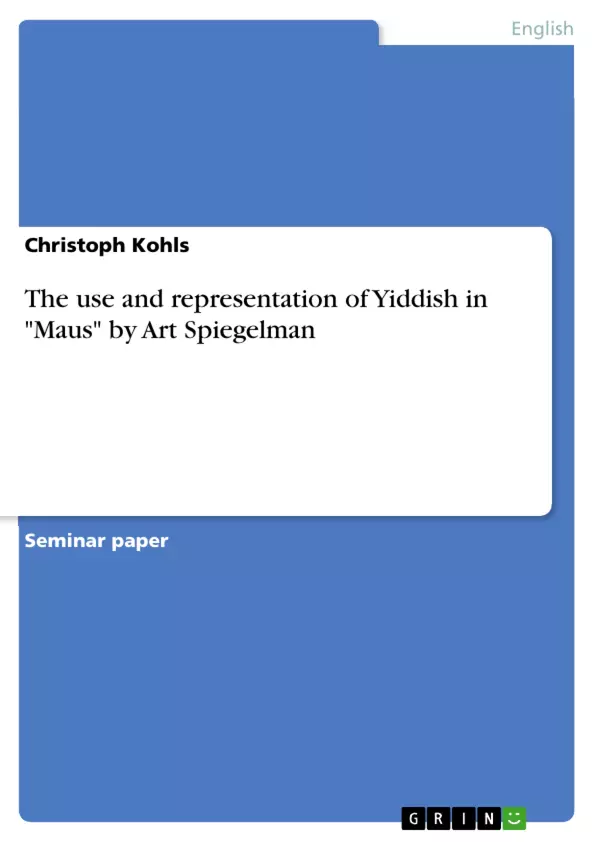In the 1930s, about 5,2 million Jews were able to speak Yiddish in Eastern Europe, but after the Second World War almost five million of them were dead. This led to a declining importance and use of the Yiddish language. But it is not a dead language but a language that gained interest of the descendants of the former yiddish-speaking Jews and research at the universities and gets more and more known. Furthermore, there are still speakers of Yiddish, mostly in the ultra-orthodox milieu in Israel.
To show that Yiddish is still used, I will examine the graphic novel “Maus“ by the American author Art Spiegelman whose parents immigrated to the USA in the early 1950s. It deals with the story of his jewish father in Poland during the Second World War. This paper shall deal with the use of Yiddish and Yinglish and its representation in the graphic novel. The aim of this paper is to show that traces of Yiddish can be found even in a graphic novel.
Following that aim, chapter I.A deals with the immigration of Jews to the USA and the impact that the big jewish community in America had on the American language – the influence of Yiddish on English and the other way round. The second chapter (II.) focuses on the life of Jews in Poland and their use of Yiddish. The chapter shall give an overview of the social premises, the Jews lived in. Nevertheless it shall also give a short introduction of the Yiddish language and how it was used. As the graphic novel deals with the Holocaust, the third chapter (III.) sums up the events after the invasion of the German Reich to Poland and shows what the Germans did to Poland. Furthermore the important polish places for the graphic novel are introduced. The next chapter introduces Art Spiegelman and gives a short biography of him. Furthermore his work “Maus“ will be represented and a short summary of the graphic novel focusing on the storyline in the 1930s and 1940s will be given. Chapter V. now analyzes the use and representation of Yiddish and in the last Chapter a conclusion will be drawn towards the question, how Yiddish is represented in “Maus“.
Inhaltsverzeichnis (Table of Contents)
- I. Introduction
- A. Yiddish, America and Yinglish/Anglish
- II. Jews in Poland and their use of yiddish
- III.The occupation of Poland by Nazi Germany
- A. Upper Silesia
- IV. Art Spiegelman
- A. The graphic novel "Maus"
- V. The use and representation of yiddish in “Maus“
- VI. Conclusion
Zielsetzung und Themenschwerpunkte (Objectives and Key Themes)
This paper analyzes the graphic novel "Maus" by Art Spiegelman to demonstrate how traces of Yiddish can be found even in a graphic novel. It examines the use of Yiddish and Yinglish in the novel, specifically in relation to the story of the author's Jewish father in Poland during World War II.
- The impact of Yiddish on American English and vice versa, creating “Anglish” and “Yinglish”
- The use of Yiddish by Jews in Poland and its social context
- The history of antisemitism in Poland and its influence on Jewish life
- Art Spiegelman's biography and his graphic novel "Maus"
- The representation of Yiddish in "Maus" and its significance
Zusammenfassung der Kapitel (Chapter Summaries)
- Chapter I.A: Discusses the influence of Yiddish on American English, exploring the concepts of “Anglish” and “Yinglish” as a result of Jewish immigration to the USA. It also examines the history of Jewish immigration to America, particularly during the late 19th and early 20th centuries.
- Chapter II: Provides an overview of the life of Jews in Poland and their use of Yiddish, highlighting the social context and the language's role in their lives. It also addresses the history of antisemitism in Poland and its impact on the Jewish population.
- Chapter III: Summarizes the events following the German invasion of Poland, outlining the atrocities committed by the Nazi regime against the Jewish population. It also introduces the key Polish locations relevant to the graphic novel.
- Chapter IV: Offers a brief biography of Art Spiegelman and introduces his graphic novel "Maus," summarizing its storyline, focusing on the events during the 1930s and 1940s.
Schlüsselwörter (Keywords)
The main keywords and focus topics of this paper include: Yiddish, Yinglish, Anglish, Jewish immigration, antisemitism, Poland, World War II, Holocaust, Art Spiegelman, Maus, graphic novel, language representation.
- Quote paper
- Christoph Kohls (Author), 2015, The use and representation of Yiddish in "Maus" by Art Spiegelman, Munich, GRIN Verlag, https://www.grin.com/document/353004



